
(a)
Interpretation:
The structural formula for
Concept Introduction:
In
In organic chemistry, reduction reaction is referred to the number
Alcohols undergo
Aldehyde undergoes oxidation to give carboxylic acid as the product while ketone does not undergo oxidation reaction.
(a)
Answer to Problem 16.45EP
The structural formula of the expected product is,
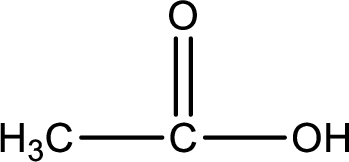
Explanation of Solution
Primary alcohol on oxidation gives aldehyde as intermediate product. This on further oxidation gives carboxylic acid as the product. The general scheme can be represented as shown below,

Given substance is,

This is a primary alcohol. The given compound is ethanol. Ethanol on oxidation gives ethanal as the intermediate product. The formed ethanal on oxidation gives ethanoic acid as the product. The complete scheme can be represented as shown below,

The carboxylic acid that is formed on oxidation of the given substance is ethanoic acid. The structural formula of ethanoic acid is given below,
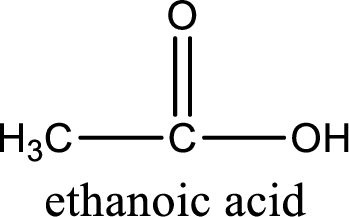
Structural formula of the carboxylic acid formed by the oxidation of given substance is drawn.
(b)
Interpretation:
The structural formula for carboxylic acid that is expected to be formed on oxidation of the given substance has to be drawn.
Concept Introduction:
In organic chemistry, oxidation reaction is referred to the number
In organic chemistry, reduction reaction is referred to the number
Alcohols undergo oxidation reaction and reduction reaction. This depends upon the number of hydrogen atoms that is bonded to the alpha carbon atom. Primary and secondary alcohol undergoes oxidation reaction while tertiary alcohol does not undergo oxidation reaction. Primary alcohols undergo oxidation to give aldehyde and carboxylic acid as product. Secondary alcohol undergoes oxidation to give ketone as the product.
Aldehyde undergoes oxidation to give carboxylic acid as the product while ketone does not undergo oxidation reaction.
Aromatic carboxylic acids are prepared from alkyl substituted benzenes.
(b)
Answer to Problem 16.45EP
The structural formula of the expected product is,
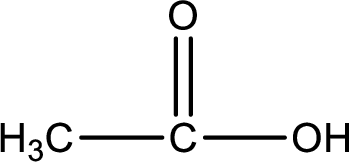
Explanation of Solution
Aldehyde on oxidation gives carboxylic acid as the product. The general scheme can be represented as shown below,

Given substance is,
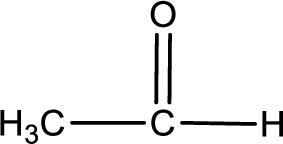
The given compound is ethanal and it is an aldehyde. Ethanal on oxidation gives ethanoic acid as the product. The complete scheme can be represented as shown below,

The carboxylic acid that is formed on oxidation of the given substance is ethanoic acid. The structural formula of ethanoic acid is given below,
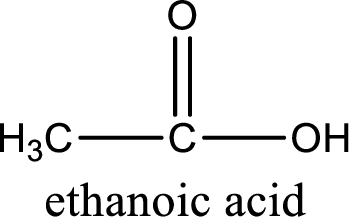
Structural formula of the carboxylic acid formed by the oxidation of given substance is drawn.
(c)
Interpretation:
The structural formula for carboxylic acid that is expected to be formed on oxidation of the given substance has to be drawn.
Concept Introduction:
In organic chemistry, oxidation reaction is referred to the number
In organic chemistry, reduction reaction is referred to the number
Alcohols undergo oxidation reaction and reduction reaction. This depends upon the number of hydrogen atoms that is bonded to the alpha carbon atom. Primary and secondary alcohol undergoes oxidation reaction while tertiary alcohol does not undergo oxidation reaction. Primary alcohols undergo oxidation to give aldehyde and carboxylic acid as product. Secondary alcohol undergoes oxidation to give ketone as the product.
Aldehyde undergoes oxidation to give carboxylic acid as the product while ketone does not undergo oxidation reaction.
Aromatic carboxylic acids are prepared from alkyl substituted benzenes.
(c)
Answer to Problem 16.45EP
The structural formula of the expected product is,

Explanation of Solution
Aldehyde on oxidation gives carboxylic acid as the product. The general scheme can be represented as shown below,

Given substance is,

The given compound is 3-methylpentanal and it is an aldehyde. 3-methylpentanal on oxidation gives 3-methylpentanoic acid as the product. The complete scheme can be represented as shown below,

The carboxylic acid that is formed on oxidation of the given substance is 3-methylpentanoic acid. The structural formula of 3-methylpentanoic acid is given below,
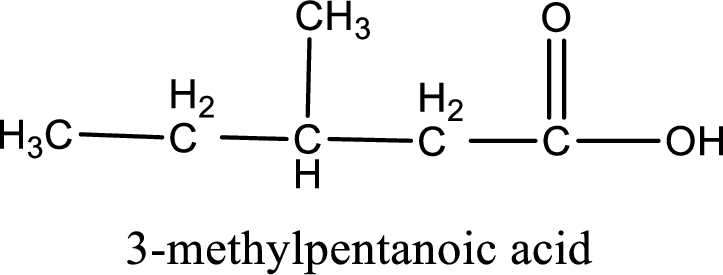
Structural formula of the carboxylic acid formed by the oxidation of given substance is drawn.
(d)
Interpretation:
The structural formula for carboxylic acid that is expected to be formed on oxidation of the given substance has to be drawn.
Concept Introduction:
In organic chemistry, oxidation reaction is referred to the number
In organic chemistry, reduction reaction is referred to the number
Alcohols undergo oxidation reaction and reduction reaction. This depends upon the number of hydrogen atoms that is bonded to the alpha carbon atom. Primary and secondary alcohol undergoes oxidation reaction while tertiary alcohol does not undergo oxidation reaction. Primary alcohols undergo oxidation to give aldehyde and carboxylic acid as product. Secondary alcohol undergoes oxidation to give ketone as the product.
Aldehyde undergoes oxidation to give carboxylic acid as the product while ketone does not undergo oxidation reaction.
Aromatic carboxylic acids are prepared from alkyl substituted benzenes.
(d)
Answer to Problem 16.45EP
The structural formula of the expected product is,
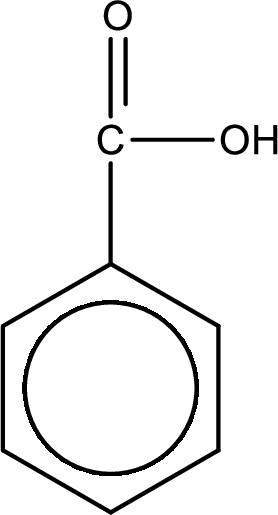
Explanation of Solution
Given substance is,
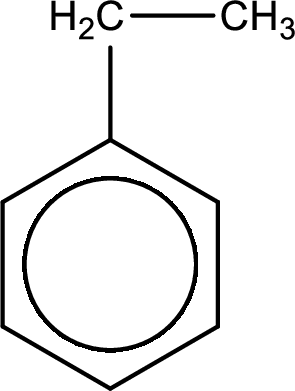
Oxidation of the alkyl side chain in a benzene derivative leads to the formation of aromatic acids. All the carbon atoms in alkyl group are lost except the one that is attached to the ring. The one carbon that is attached to the ring becomes a part of carboxyl functional group. This can be depicted as shown below,

The product formed is benzoic acid.
Structural formula of the carboxylic acid formed by the oxidation of given substance is drawn.
Want to see more full solutions like this?
Chapter 16 Solutions
EBK GENERAL, ORGANIC, AND BIOLOGICAL CH
- What is this?arrow_forwardMolecular Biology A-C components of the question are corresponding to attached image labeled 1. D component of the question is corresponding to attached image labeled 2. For a eukaryotic mRNA, the sequences is as follows where AUGrepresents the start codon, the yellow is the Kozak sequence and (XXX) just represents any codonfor an amino acid (no stop codons here). G-cap and polyA tail are not shown A. How long is the peptide produced?B. What is the function (a sentence) of the UAA highlighted in blue?C. If the sequence highlighted in blue were changed from UAA to UAG, how would that affecttranslation? D. (1) The sequence highlighted in yellow above is moved to a new position indicated below. Howwould that affect translation? (2) How long would be the protein produced from this new mRNA? Thank youarrow_forwardMolecular Biology Question Explain why the cell doesn’t need 61 tRNAs (one for each codon). Please help. Thank youarrow_forward
- Molecular Biology You discover a disease causing mutation (indicated by the arrow) that alters splicing of its mRNA. This mutation (a base substitution in the splicing sequence) eliminates a 3’ splice site resulting in the inclusion of the second intron (I2) in the final mRNA. We are going to pretend that this intron is short having only 15 nucleotides (most introns are much longer so this is just to make things simple) with the following sequence shown below in bold. The ( ) indicate the reading frames in the exons; the included intron 2 sequences are in bold. A. Would you expected this change to be harmful? ExplainB. If you were to do gene therapy to fix this problem, briefly explain what type of gene therapy youwould use to correct this. Please help. Thank youarrow_forwardMolecular Biology Question Please help. Thank you Explain what is meant by the term “defective virus.” Explain how a defective virus is able to replicate.arrow_forwardMolecular Biology Explain why changing the codon GGG to GGA should not be harmful. Please help . Thank youarrow_forward
- Stage Percent Time in Hours Interphase .60 14.4 Prophase .20 4.8 Metaphase .10 2.4 Anaphase .06 1.44 Telophase .03 .72 Cytukinesis .01 .24 Can you summarize the results in the chart and explain which phases are faster and why the slower ones are slow?arrow_forwardCan you circle a cell in the different stages of mitosis? 1.prophase 2.metaphase 3.anaphase 4.telophase 5.cytokinesisarrow_forwardWhich microbe does not live part of its lifecycle outside humans? A. Toxoplasma gondii B. Cytomegalovirus C. Francisella tularensis D. Plasmodium falciparum explain your answer thoroughly.arrow_forward
- Select all of the following that the ablation (knockout) or ectopoic expression (gain of function) of Hox can contribute to. Another set of wings in the fruit fly, duplication of fingernails, ectopic ears in mice, excess feathers in duck/quail chimeras, and homeosis of segment 2 to jaw in Hox2a mutantsarrow_forwardSelect all of the following that changes in the MC1R gene can lead to: Changes in spots/stripes in lizards, changes in coat coloration in mice, ectopic ear formation in Siberian hamsters, and red hair in humansarrow_forwardPleiotropic genes are genes that (blank) Cause a swapping of organs/structures, are the result of duplicated sets of chromosomes, never produce protein products, and have more than one purpose/functionarrow_forward
 Human Physiology: From Cells to Systems (MindTap ...BiologyISBN:9781285866932Author:Lauralee SherwoodPublisher:Cengage Learning
Human Physiology: From Cells to Systems (MindTap ...BiologyISBN:9781285866932Author:Lauralee SherwoodPublisher:Cengage Learning Anatomy & PhysiologyBiologyISBN:9781938168130Author:Kelly A. Young, James A. Wise, Peter DeSaix, Dean H. Kruse, Brandon Poe, Eddie Johnson, Jody E. Johnson, Oksana Korol, J. Gordon Betts, Mark WomblePublisher:OpenStax College
Anatomy & PhysiologyBiologyISBN:9781938168130Author:Kelly A. Young, James A. Wise, Peter DeSaix, Dean H. Kruse, Brandon Poe, Eddie Johnson, Jody E. Johnson, Oksana Korol, J. Gordon Betts, Mark WomblePublisher:OpenStax College Human Biology (MindTap Course List)BiologyISBN:9781305112100Author:Cecie Starr, Beverly McMillanPublisher:Cengage Learning
Human Biology (MindTap Course List)BiologyISBN:9781305112100Author:Cecie Starr, Beverly McMillanPublisher:Cengage Learning





